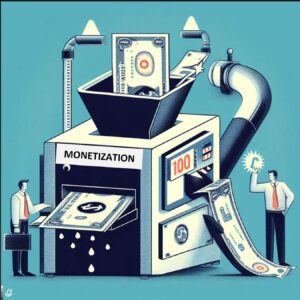OpenAI Has Five Possible Paths To Monetization
What OpenAI’s Future Monetization Model Might Mean For The Company — And For You
 OpenAI has been all over the news recently, for all the wrong reasons. A dramatic showdown between members of the board of directors, company executives, investors, and even employees caught everyone’s attention. But behind the lurid details of this saga lies a fundamentally valid question: What will OpenAI’s future operating model be? Answering this question isn’t as straightforward as it would be for other companies. But the stakes are high for leaders of organizations considering building upon OpenAI’s platform or investing in Microsoft’s Copilot offerings, which are deeply intertwined with OpenAI’s technology.
OpenAI has been all over the news recently, for all the wrong reasons. A dramatic showdown between members of the board of directors, company executives, investors, and even employees caught everyone’s attention. But behind the lurid details of this saga lies a fundamentally valid question: What will OpenAI’s future operating model be? Answering this question isn’t as straightforward as it would be for other companies. But the stakes are high for leaders of organizations considering building upon OpenAI’s platform or investing in Microsoft’s Copilot offerings, which are deeply intertwined with OpenAI’s technology.
Evolving Away From Nonprofit Status Opened Pandora’s Box
OpenAI’s unusual mandate and history inform its options. The company’s self-proclaimed “primary fiduciary duty is to humanity,” not investors. Things only grew more messy over time:
- It pivoted from nonprofit to “capped profit.” Founded in 2015 as a nonprofit, OpenAI shifted to being “capped profit” in 2019. The company declared that only a profit-seeking model would help it generate the capital it needs: “We’ll need to invest billions of dollars in upcoming years into large-scale cloud compute, attracting and retaining talented people, and building AI supercomputers.”
- For-profit status created new stakeholders. Reporting suggests that Microsoft owns 49% of OpenAI, other investors and employees own 49%, and OpenAI’s nonprofit owns 2%. With 98% of the company owned by investors, the fundamental charter, and the board tasked with enforcing it, came under contradictions and pressures. Recent events seem to have confirmed reinstated CEO Sam Altman’s view, which appears to be aligned with for-profit status and the company’s investors.
OpenAI Has Five Options For Monetization Going Forward
In October 2023, reporting suggested that OpenAI crossed $1.3 billion in annual revenue, up from $28 million in 2022. For OpenAI to further scale its grand ambitions, it will need to evaluate five routes to monetization; a sixth option, soliciting donations as Wikipedia does today, was no longer on the table once the transition from nonprofit to capped profit occurred. In order from most likely to least likely, those monetization options include:
- Licensing the model. Licensing has already become core to OpenAI’s strategy, with Microsoft the top customer on its list. Microsoft 365 Copilot, a promising tool using generative AI (genAI) to boost employee productivity and collaboration, rests upon a foundation of OpenAI’s models. Blockbuster licensing deals can drive high revenue — though at the expense of overdependence on a single buyer. Licensing more broadly can generate high margins but with a long tail of (lower) revenue. Leaders at enterprise companies would look to understand OpenAI technology as the “Intel Inside” of genAI, a component implying quality … at least as of late 2023. In this fast-moving market, OpenAI’s technology might not remain on top for long.
- Becoming a full enterprise service provider. OpenAI offers an enterprise SKU of ChatGPT today, offering high-speed GPT-4, APIs to build your own solutions, data analytics, and a management console, among other features. OpenAI also offers custom data sets to help enterprises start their genAI journey faster. These offerings represent something of a departure for OpenAI; the company’s core competency has been in building and training foundational models, not services. But the enterprise service opportunity might be a crucial one for OpenAI if it wants to maintain its high-profile position in the market. Yet being an enterprise services company requires deep channel and sales capabilities, which are hard to execute. Leaders at enterprises would want to carefully evaluate whether OpenAI has become sophisticated enough to act in this capacity or whether they should buy from an OpenAI partner like Microsoft or from a service provider using OpenAI technology.
- Monetizing an app store of custom GPTs. On November 6, OpenAI launched custom GPTs, which require no code but can add instructions and data to solve specific problems. Soon, developers will be able to distribute through the GPT Store, which will then allow them to charge money. Perhaps GPT Store evolves into a marketplace that’s part Apple App Store, part Salesforce AppExchange — the idea being to incentivize developers to develop exciting value-added products and sell them at scale. The app store isn’t fully developed yet, but leaders would want to look at the Salesforce AppExchange model plus the privacy and security model of custom GPTs to begin their evaluation.
- Selling direct to consumer. Over a hundred million consumers have used free ChatGPT, but are they willing to pay? The $20/month fee-based approach might struggle to attract and retain subscribers, particularly with free search and competing genAI alternatives available in the market. X, formerly Twitter, has attempted exactly this approach, the success of which is hard to ascertain given the rest of what’s happened to the organization under Musk’s stewardship. This model would impact bring-your-own AI, as it is doing today, necessitating policies and management.
- Embracing advertising. Online advertising starts as a massive loss leader but has the potential to be highly profitable when it achieves massive scale. But reaching advertising scale is challenging; Microsoft only earns $12 billion in advertising revenue compared with over $200 billion for Google. More core to the product, genAI already has the potential to hallucinate and generate coherent nonsense. If ChatGPT suddenly inserted sponsored advertising as answers, how would that impact user acceptance of outputs? This option by itself would significantly reduce the enterprise appeal due to privacy and security concerns.
Will OpenAI Be More Like BlackBerry Or Microsoft Office?
Given all the moving pieces over the past week, it would be premature to firmly predict which option — or combination of options, more likely — that OpenAI will pursue. But you’ll want to keep an eye on which path it chooses as you navigate your use of its platform and technology. Our Forrester colleague Mike Gualtieri believes that OpenAI will be the BlackBerry of genAI, primarily because, while it has a genuine early-mover advantage, its ultimate destiny will be shaped by rising competition, open source models, and differentiated training data.
The monetization question contributes to this debate: The model itself can build in sustainable differentiation in how the solutions are packaged and delivered, even if, in the long run, there will be a lot of generative AI competitors, more similar to the way Microsoft Office (now Microsoft 365) still dominates the office application suite market not by virtue of a monopoly on good spreadsheet software but because Microsoft has developed a model that is sticky — an advantage that survived even when Microsoft had to disrupt that model when it moved from software licenses to the M365 subscription approach. And of course, not coincidentally, now Microsoft is betting that OpenAI’s technology will help it cement M365’s value — and market advantage — with Copilot well into the future.
Rowan Curran, James McQuivey, Ted Schadler, Mike Gualtieri, and Srividya Sridharan all contributed to the content of this blog post.
